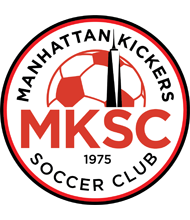Darryl Vigon, founder of the Manhattan Kickers recently contacted me. Connecting through the wonder of websites and email, Darryl has offered this brief history and background on the origin of the Manhattan Kickers. Today, Darryl is living in New Jersey and works with his wife. They own and operate “Miss Patti’s School of Dance.”
Q: How did youth soccer begin in the community?
Vigon: It began in the early spring of 1975, when I brought a group of Cub Scouts from the community to a soccer clinic in Queens and wound up playing in the German-American Junior League. In the summer of 1976, I prepared and distributed a communication to the community (which promoted and officially outlined a youth soccer program), giving birth to the Manhattan Soccer Club...officially dubbed "Kickers".
Q: What made you bring the troop to the clinic in Queens? Where did you play games?
Vigon: The possibility of inspiring more than a dozen boys at the clinic, which was run by representatives of the Hellenic Sports Club, could not be passed up. The Sports Club had a formidable men’s team in the German-American Senior Soccer League. Mr. Peter Anastopoulas, who was affiliated with the League, was also a Parks Department coordinator for use of soccer fields in Queens and that’s where games were played. The boys were inspired and motivated to come back the following week for another clinic session.
Q: From the start, the Kickers was a travel-only program, correct?
Vigon: Yes, that’s correct. Shortly after I had been bringing the troop to the clinics, I was asked if I would coach a Hellenic boy’s team that would compete in the League. So, as a neophyte coach and team, we got our first introduction to soccer in 1975 in the Boys B Division of the German-American Junior Soccer League (soon to be renamed the Cosmopolitan Junior Soccer League).
Q: Aaron Retica, currently a volunteer coach with two daughters playing in the Kickers was one of the Cub Scout members in the troop that you took to Queens. He tells tales of falling in defeat to the other travel teams in the Cosmopolitan League. What was that like and how did you keep players interested in spite of the losses?
Vigon: We lost our first game, 6-0, to Blue Star of Lawrence, Long Island, enlightening me to the task ahead. As a coach, I was committed to learning the game and it became the mission of the team to do the same. Through hard work and improved recruitment efforts, the team rose to become one of the top teams in the Cosmopolitan Junior Soccer League. In the sixth and last year competing as a team, a core of the “original” Cub Scout troop members remaining from that first year fulfilled “their mission” by winning the Cosmopolitan League Indoor Championship in Junior A Division competition and placing second in outdoor A Division competition by losing the championship game to Ridgewood.
Q: The sport of soccer is more popular than ever these days, but 30 years that was not the case. How did you solicit and recruit players?
Vigon: Through advertising in the local paper, Town & Village and at all the schools in the community. The newness of the sport and the fact that it was fun was a big draw.
Q: How long did you lead the program?
Vigon: For eight years, from 1975 until 1983. In 1983, when I “retired” from the Manhattan Kickers, the youth soccer organization had eleven traveling teams in the Cosmopolitan League, a men’s team and approximately 400 boys and girls in the Intramural Program.
Q: The legacy you describe remains intact today and the number of youth soccer players continues to increase. What stands out most for you as you reflect on the development of the organization?
Vigon: The volunteers who stepped forward and formed the first Board of Directors for the Kickers, putting forth their efforts to bring soccer to the community. Many of these Directors, like myself, had limited soccer experience, and in addition to their administrative duties, coached teams, spending many hours learning the game, its rules, techniques, and team concepts.
Q: Again, that legacy of “volunteerism” is evident today. Without volunteers, there would not be Youth Soccer on the Eastside of Manhattan. What do you remember most about coaching?
Vigon: As coach of the Kickers' first team that began in the 1975 Boys Division and ended in 1981/82 Junior Division, I remember the maturity and development of those boys who, to this day, I am so very proud of when I think of their dedication, level of play and great sportsmanship.
Q: And of course the fact that some of those very boys, like Aaron Retica, are following in your footsteps today! One final question, whom did you transition leadership to?
Vigon: Following my resignation, Burke O’Hara became the Club’s Executive Director for what may have been one or two years. Chris Rainey was the Club’s first Intramural Director. Rainy was succeeded by Lydia Brown, and from what you tell me, John and Patty Burr succeeded Lydia. During those early years, the Executive Director oversaw the entire Club organization and its operations.
Epilogue: In speaking with Darryl, I learned that much of what we do today - organizing, recruiting, and permitting fields parallels what he did for the first time over 30 years ago. It turns out that he was responsible for obtaining the first permit to East 6th Street from the Parks Department and for arranging use of the Con Edison Fields. In addition, the development of the Intramural Program today is as crucial to the success and development of the Travel Program as it became in the late 70’s. One final footnote: Both Darryl and I agree that if not for the volunteers both yesterday and today - the Kickers could never have sustained its presence on the eastside of Manhattan.
